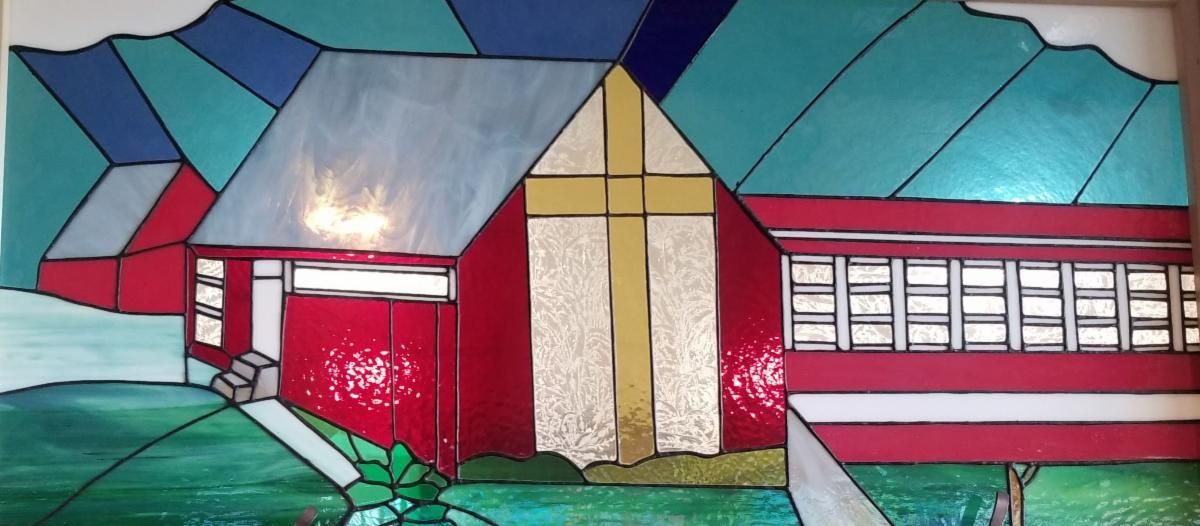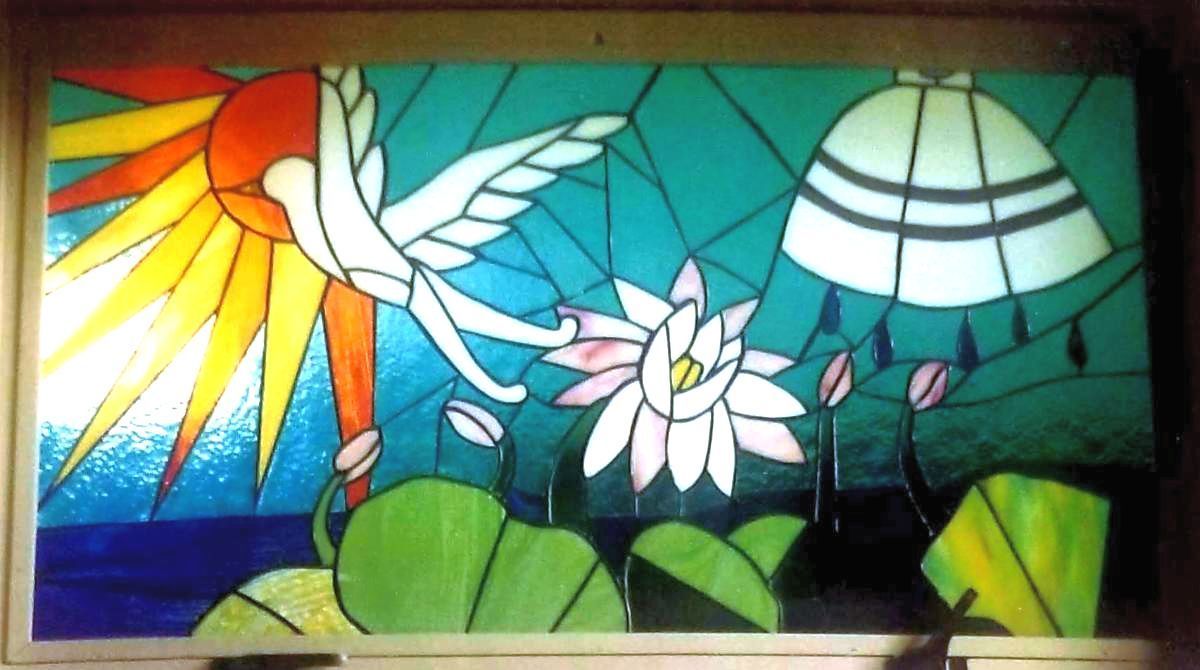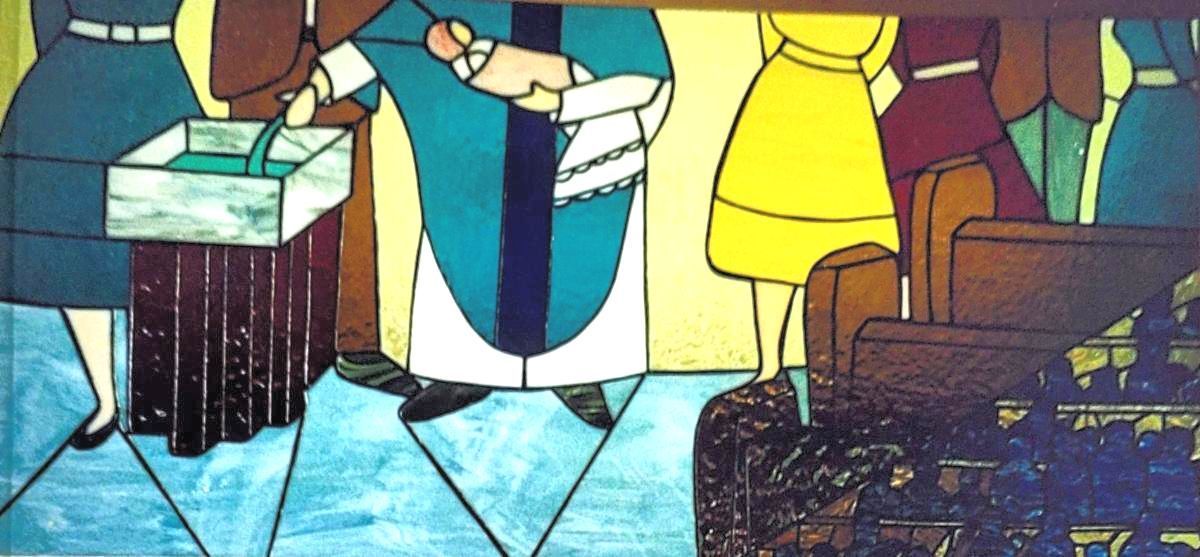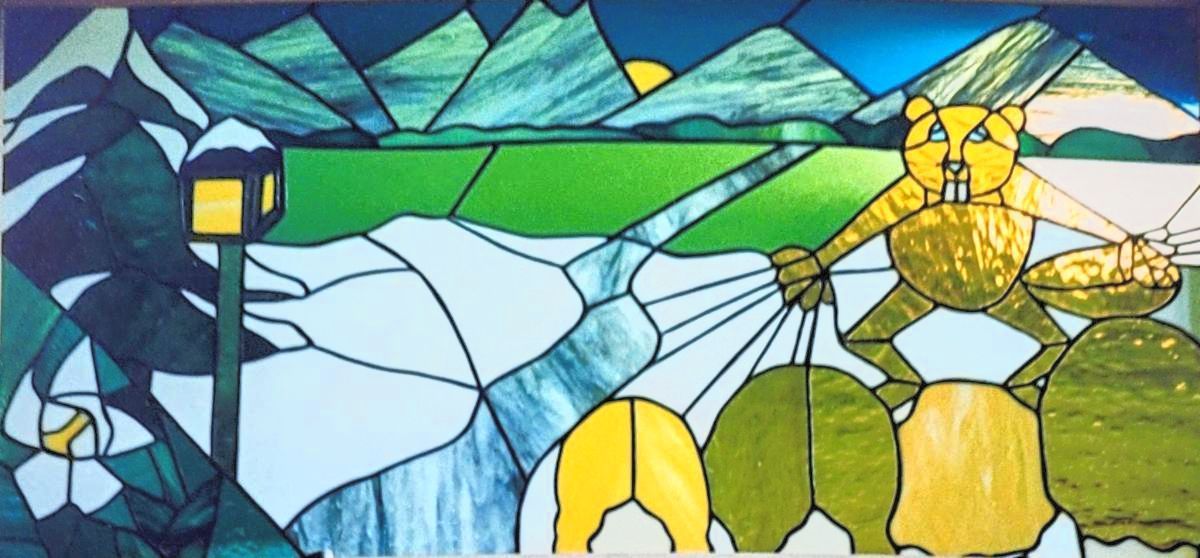Our Windows
Text describing the planning, design, creation, and installation of the windows will go here.
The window descriptions below are adapted from material published at the time of their installation.
Window #1: Early Building
Given by Peg and Jim Barnewall in loving memory of Robert G. Olsson. Dedicated July 3, 1988. Description adapted from original published in church bulletin at the time of installation. Photo by Kathy Prue.

Located at the entrance to the Nave, this window depicts the early development of the church property during the 1950s. The rectory can be seen behind the church building; the perspective is distorted to imply that as a young congregation without the mature judgment of older members, we sometimes had to struggle very hard to keep everything in perspective, to see our own needs for God as distinct from the needs of our children.
In the ’50s, everything revolved around education of our children, often with little thought for our own Christian growth, which would have had more profound effect on our children than all the church school classes they would ever attend.
The small Austrian pine in the foreground is a symbol of our growth, which, along with the twig-like deciduous tree in front of the parish house [now Dwyer Hall] reinforces the idea of growth and youth.
Window #2: Baptism
Installed the week of February 14, 1988. Description adapted from original published in church bulletin at the time of installation. Photo by Kathy Prue.

The scallop shell is a symbol of baptism. Baptism washes away the guilt of original sin and imparts the regenerating grace of the Holy Spirit through union with Christ. The lotus, a blossom suggestive of beauty and purity with its roots in the mud, implies that the life of the Christian may, by grace, rise through and above unlovely and evil influences. The dove signifies the Holy Spirit’s presence over the waters at Creation and descending upon Jesus at his baptism.
Window #3: Holy Baptism / The People
Given by Liz (Dales) Swartz in memory of H. Joseph & Lily L. Leavitt. Installed the week of May 15, 1988. Photo by Kathy Prue.

This window represents the characteristic sacramental activity of the 1950s decade: the baptism of infants. It complements the window next to it which symbolically represents the sacrament of Holy Baptism, which during these years was frequently administered in our congregation of young and growing families. Because the church at this time was collectively and numerically strong, the figures in the window are depicted anonymously.
The small triangular inset in the lower right corner depicts what the congregation looked like in the 1950s. The silhouettes reveal a parish family predominantly young with many children, the result of the post-World War II “Baby Boom.” This composition is based on photos of parish worship during that time.
Window #4: Narnian Picture (Mr. Beaver)
Given by Monica & Oscar Groves in honor of Oscar and Mary Groves and family. Installed the week of October 9, 1988. Photo by Kathy Prue.

This window depicts scenes from The Lion, the Witch, and the Wardrobe, the first of C.S. Lewis’s children’s books set in the magical world of Narnia. It depicts Mr. Beaver, a talking Narnian animal, telling the four “Sons of Adam and Daughters of Eve,” who have entered this world, about Aslan the Lion for the first time.
Although most of the land is encased in snow, the far-off mountains are turning green with the hint of spring—a sign that Aslan is coming and the White Witch’s winter-spell is breaking. The beaver, an important character in the tale, is also coincidentally a symbol of our Diocese. The always-shining lamppost suggests the light of the Lord. The lily in the lower corner reminds us that this tale points to the story of Christ’s Resurrection. The road indicates that the Christian life, though difficult, leads to renewal and the fulfillment of hope.
The overall colors of this window suggest the feeling of cold and ice. It largely lacks the warm colors with which all the other windows are composed. And yet, there are signs of imminent dawn and the coming of spring. This window shows that, despite the indifference of the world, our hope in the resurrection is always alive. Where this hope is cultivated, God melts the icy cold of pessimism, defeatism and indifference, causing new life to burst forth.
More windows will be added to this page over time. . . .

